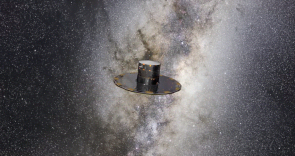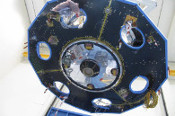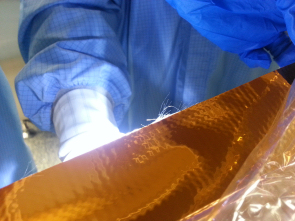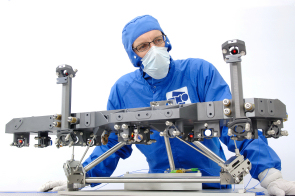Gaia's second anniversary marked by successes and challenges
16 August 2016
Operating in the depths of space, far beyond the Moon's orbit, ESA's Gaia spacecraft has now completed two years of a planned five-year survey of the sky. Despite a series of unexpected technical challenges, the mission is on track to complete the most detailed and complex mapping of the heavens ever undertaken. |
| Gaia scanning the sky. Credit: ESA - C. Carreau Click here for the animation and details. |
Selected as one of the 'Cornerstone' missions of ESA's science programme, Gaia is designed to pinpoint the positions, distances, motions and other properties of more than a billion stars. Its three instruments collect astrometric, photometric and spectroscopic data on stars in the Milky Way galaxy, as well as more distant galaxies and quasars, and nearby, but faint Solar System objects.
Located at the L2 Lagrange point, 1.5 million km from Earth, Gaia surveys the entire sky as it spins on its axis. By repeatedly measuring the positions of the stars with extraordinary accuracy, Gaia is providing a huge treasure trove of data that enables scientists to tease out their distances and motions through our Galaxy.
"More than 50 billion focal plane transits, 110 billion photometric observations and 9.4 billion spectroscopic observations have been successfully processed to date," notes Fred Jansen, ESA's mission manager for Gaia.
The immense volume of data and their complex nature have required a huge effort from the scientists and software developers, distributed across Europe, who make up Gaia's Data Processing and Analysis Consortium (DPAC). The first product of their efforts will be a public data release scheduled for 14 September.
"The spacecraft is working well and the data processing is on the right track," says Timo Prusti, ESA's project scientist for Gaia. "Most of the spacecraft systems that are crucial for the success of our mission have behaved as well as, or even better than, expected.
"These include the focal plane assembly, onboard data handling system, onboard detection of sources, the phased array antenna, and the attitude control and micro-propulsion subsystems."
.JPG) |
 |
 |
| The Gaia payload module (left), focal plane assembly (centre), and the phased array antenna (right). Credit: ESA/Airbus DS |
||
Nevertheless, the first two years of Gaia operations have not been without their challenges. A few largely unforeseen problems have occurred, requiring detailed, ongoing investigations by teams from ESA, industry and the DPAC.
One problem detected early in the commissioning phase was associated with water freezing on some parts of the optics, causing a reduction in the sensitivity of the telescopes. The mission team expected some water to be trapped in the spacecraft before launch, followed by freezing once the spacecraft reached orbit and started to outgas. Gaia's mirrors were already equipped with heaters to take care of this. However, the amount of ice was much more than expected and the ice deposits survived the heating procedure that took place early in the mission.
"During the commissioning phase, we noticed that there was a rapid drop in transmission from the mirrors, but this disappeared when the affected optics were heated to remove the ice," says Prusti. "This process of decontamination has now taken place a couple of times, and after each occasion the optics have remained clear for longer periods of time.
"The last heating operation took place in June 2015, and only now is the contamination beginning to return very slowly. However, this is not a major setback, since Gaia can still detect objects down to magnitude 20.5, compared with its optimal detection of stars at magnitude 20.7 [1]. We plan to decontaminate the mirror again in the near future, but we are confident that we have now largely solved this problem, and the impact on the overall mission outcome is minimal."
 |
| Fibres on edge of Gaia's sunshield. Credit: ESA/Airbus DS |
A second complication is caused by stray light infiltrating into Gaia's focal plane at a level higher than predicted before launch. Light from very bright stars and the Milky Way is reflected onto the focal plane, but the more serious stray light is coming from sunlight being scattered by minute fibres around the edge of the insulating blanket that covers Gaia's 10 m diameter sunshield.
"This results in higher background 'noise' in the data," explains Prusti. "This is irrelevant for observations of brighter stars, but more significant for fainter stars. We can still easily detect stars of magnitude 20, but the stray light means that we can pinpoint locations of faint stars to an accuracy of 500 microarcseconds [2] instead of the planned 300 microarcseconds. However, it is important to stress that, despite this 'noise', Gaia is still the most accurate star mapper ever built."
Another surprise is a series of minor mechanical vibrations which Timo Prusti dubs 'micro-clanks'.
"Thermal expansion and contraction effects are seen on all spacecraft, which results in so-called 'clanks'," he says. "The mechanical changes on Gaia are much smaller than normal, and the only reason we can detect them is because its attitude control system is so sensitive.
"We have discovered that the micro-clanks cause minute structural changes within the spacecraft which lead to tiny discontinuities in the rotation angle of the spacecraft. They result in small inaccuracies in the timing and positions of the stars as they pass across Gaia's array of CCDs.
"However, we are not too worried about this because we can see when it is happening and we know how to fix it. New software will be implemented next year to remove the effect from the data."
A similar effect is caused by micrometeorites, specks of space dust that strike the spacecraft at high speed. However, this environmental hazard was well understood and predicted before launch.
"Fairly large impacts may occur a few times each month," says Jansen. "If they change the spacecraft's rotation rate by more than 10 milliarcseconds per second, they can adversely affect the science data, but such events are rare and their impact on the overall science data return is very small."
 |
| Basic Angle Monitor. Credit: TNO, Fred Kamphues |
Finally, the Gaia team has been analysing data from a laser device called the 'basic angle monitor'. The instrument is designed to measure, with an extremely high level of accuracy, any variations in the angle of separation between Gaia's two telescopes. This is necessary in order to correct for expected periodic variations in the separation angle caused by thermal changes in the payload as Gaia spins.
Knowing this basic angle to an accuracy of 0.5 microarcseconds every 15 minutes is crucial in order to achieve absolute global astrometry – mapping of stellar positions - and it is an essential requirement in the data analysis process. However, during commissioning, it was noted that the basic angle fluctuates periodically, at a level more than 100 times greater than expected.
Careful investigation has concluded that the variation is probably caused by thermal expansion and contraction resulting from some solar heat reaching the payload via the service module.
"We have confirmed that the basic angle monitor is operating properly and we have been able to model the effect on the ground," says Jansen. "This shows that there is a regular pattern of basic angle variation during each rotation of the spacecraft.
"The spacecraft operations have been tuned to ensure a constant amount of solar heating in order to minimise thermoelastic variations."
"We have taken the basic angle variation into account while processing the data for the first data release in September and we are continuing efforts to develop software that will largely eliminate the problem for future data releases," says Prusti.
The past two years have been a steep learning curve for all of the Gaia team, especially the DPAC, which has had to cater for the unexpected anomalies by developing additional software beyond that foreseen for the processing required for the first data release.
However, the team is happy with the condition of their spacecraft and confident that they can overcome the lingering observational problems to create the most accurate, detailed sky map ever made.
"Although the mission has experienced a number of technical challenges, all of these have either been mitigated by additional software and analysis, or the mitigating mechanism is known and tested but full implementation is pending," says Jansen. "Overall, through the extensive efforts of ESA, DPAC, and prime contractor Airbus Defence and Space, these effects have had a limited impact on our ability to achieve the mission's original science objectives."
"We are confident that we shall still be able to analyse more than one billion stars, measuring each star's position and motion up to 100 times more accurately than Gaia's predecessor Hipparcos," says Prusti.
Notes
[1] The magnitude scale is a logarithmic scale used to indicate the apparent brightness of stars. An increase or decrease of 1 magnitude is a change by a factor of 2.512. As an example, a magnitude 20 star is about 400 million times fainter than the brightest star in our sky, Sirius, which has an apparent magnitude of -1.46.
[2] Minutes, or seconds, of arc are used to describe very small angles. An arcminute is 1/60 of a degree and an arcsecond is 1/60 of an arcminute. A microarcsecond, which is one millionth of an arcsecond, is equivalent to the edge of a euro coin on the Moon as seen from Earth.
Further information
Gaia was launched on 19 December 2013 and after a six-month in-orbit commissioning period, the satellite started routine scientific operations on 25 July 2014.
The first Gaia data release, available online on 14 September, will include the positions and G magnitudes for about one billion stars using observations taken between 25 July 2014 and 16 September 2015. In addition, parallaxes and proper motions will be available for the brightest two million stars, as part of the Tycho-Gaia Astrometric Solution.
For the first 28 days of the routine scientific operations phase, Gaia operated in a special scanning mode that sampled great circles on the sky that always included the ecliptic poles. Photometric data for RR Lyrae and Cepheid variable stars that were observed frequently during this period will be part of the first data release.
On 21 August 2014, Gaia commenced its main survey operation, employing a scanning law designed to achieve the best possible coverage of the whole sky.
Contacts
Timo Prusti
ESA Gaia project scientist
Directorate of Science
European Space Agency
Email: tprusti![]() cosmos.esa.int
cosmos.esa.int
Fred Jansen
ESA Gaia mission manager
Directorate of Science
European Space Agency
Email: fjansen![]() cosmos.esa.int
cosmos.esa.int






